
STILL SOMETHING OF A SUMMIT MEETING
In a world that looks upon Ping-Pong as a diplomatic breakthrough, the once intensely contested track meet between Russia and the U.S. has come to be a quiet note in the background, a comfortable old affair that has long since lost the hot-eyed glamour of its youth. Which is a shame, really. The meet may provoke yawns in diplomatic circles—and even among those who run, jump and throw—but there are those who love it, and it can still give off sparks. This happened again last week in Berkeley, in the University of California's Edwards Stadium, when a relatively obscure American high jumper named Pat Matzdorf leaped 7'6¼" to break one of track and field's most revered world records, the 7'5¾" mark set by Russia's Valeri Brumel back in 1963.
Matzdorf, who is tall and slim, with sloppy brown hair, long sideburns and a soft, modest little mustache, is a 21-year-old math major from the University of Wisconsin whose previous best was 7'2" (the highest he ever even tried was 7'4"—in practice) and whose most notable accomplishment had been a second place behind Reynaldo Brown in the AAU championships a week earlier. Against the Russians, Matzdorf climbed to 7'3" with Brown and kept going up after Brown faltered. "I didn't shave this morning because I wanted to feel mean," he said later.
He set a new U.S. record at 7'4½" (topping the height Dick Fosbury reached in winning the Olympic high jump at Mexico City) and then barely missed in his first two attempts at the world record. On his final attempt he twisted over the bar, brushing it as he did, and then lay on his back on the landing pad watching with trepidation as the bar vibrated. But it stayed put, and Matzdorf sprang out of the pit in triumph.
That was the big moment in the American men's 126-110 victory, their eighth in 10 meetings with the Russians. The U.S. girls, despite pre-meet optimism, were ground down by their Soviet counterparts, 76-60, the ninth time they have lost (they have won only once) in a series that started back in 1958 as a warm touch in the cold war. Last week's meet included a skimpy collection of athletes ostensibly representing the rest of the world. The rest of the world did not do too well as a team, finishing last behind the American-Russian juggernaut.
Early evidence that the edge had gone from the meet's appeal was provided by the absence of some outstanding Americans who could have been on hand but weren't. Marty Liquori, the best miler in the world, was doing his thing in Europe. So were Ralph Mann, world-record holder in the 440-yard hurdles, and John Smith, world-record holder in the 440-yard run. Jay Silvester, world-record holder in the discus throw, had taken the wife and kids on a tour of Europe, while America's best hammer thrower, George Frenn, was mad at the AAU and stayed home.
"It is a great pity that the best Americans are not competing here, that they don't think this meet is important," said Russia's stocky 32-year-old Janis Lusis, the 1968 Olympic javelin champion, who then put down the meet himself with faint praise: "This meet is important—not as important as this summer's European Championships, of course, but important because this will help us get in shape for it."
Lusis was one of only a handful of oldsters on a team that the Soviets hope is the vanguard of a youth movement that will revive Russia as a world power in track. The oldest of all—in experience anyway—is 33-year-old Igor Ter-Ovanesyan, the enduring long jumper who has competed in nine of the 10 Soviet-American meets. Ter-O put the present state of the series in perspective. Slouched comfortably on a sofa in the lounge of the University of California residence hall that was being used as the meet dormitory, wearing brown slacks, brown plaid jacket and a burgundy and white sports shirt open at the collar, he said in his excellent, amiable English: "It is much more of a relaxed competition now, even more so than last year. In the old days it was very serious. Everyone used to be so nervous. We didn't know each other then. But even so, this meet is still most important to us because American track and field is the best in the world."
At 33, what kind of shape is the ageless Igor in?
"I may be 33, but I keep feeling younger," he smiled. "Maybe it's because I'm half Armenian. I want to compete all my life. You know, I have never won my event in this dual meet. I'm always second. I'm afraid to think about it, so I won't. We have a writer at home who has said, 'You are not a brave man if you take part in a fight and are worrying about who will finish first or second, who will be the winner or the loser. You should just go and fight.' So that is what I will do, all that I can."
Igor's attitude contrasted notably with that of the U.S. team as its members limbered up before the meet. Most were competing for reasons that did not have much to do with the meet's status as a sporting classic.
"Heck, I can easily see why some of the guys would rather be in Europe than here," said distance runner Steve Prefontaine, now 20 and just finished with his sophomore year at Oregon. "I almost decided to go to Europe myself, but maybe I'm patriotic or something. I was on the team that lost last year in Leningrad, and I want to do my part in reestablishing our supremacy."
Bill Skinner, who won the javelin throw last year, said he could not get too excited about this year's event. "I like to throw against Lusis because he's such a great technician," said Skinner. "I enjoy watching him up close. If I lose? Well, I beat him last year. The worst that losing could do would be to make us even." And so it went among most of the Americans. Only the girls seemed to be fired up, and it did not do them much good.
Friday, the first day of the meet, was clear and sunny, but a cold wind cut across the pink clay and cinder track and performances were uninspiring in almost every event. Doris Brown, her long blonde hair tied up with red ribbons, did make a courageous bid to upset the Russian girls in the 1,500-meter run, but after a fierce last-lap sprint she was edged by Tamara Pangelova in the good time of 4:13.8. The other women's events ran close to form and at the end of the day the American girls trailed by a fat 11 points, 42-31. Nor did the American men do much to arouse the crowd. It was the men in the red track shirts who provided what excitement there was. The stocky little Russian sprinter, Valeri Borzov, who last year at Leningrad jumped the gun to win, got his victory honestly this time. Plugging into a head wind of eight mph, he edged Jim Green of Kentucky by a foot to take the 100-meter dash in a slow 10.5, while Dr. Delano Meriwether, after a hectic week in which he and his wife Mary moved from Baltimore to Boston, finished a disappointing fifth.
The two distance races on Friday were also something of a disaster for the U.S. After a slow early pace in the 10,000, a startling sprint sent Russia's Rashid Sharafyetdinov, a tiny man with a thin dark mustache and the mischievous expression of a small boy, to a 30-yard victory over Frank Shorter. A similar sprint finish, this time by two mischievous Russian boys, produced a Soviet sweep in what had been a dawdling 1,500 meters. At the end of the day the U.S.S.R. led 54-53.
This left Steve Prefontaine seething. "I am really p.o.'d," he snarled before going out to dinner. "What a stupid race we ran in the 1,500. Can you believe our guys letting the Russians sit there behind a slow pace like that? I'm angry, and when I get angry I get mean. It's a cinch we're not going to set a slow pace in the 5,000."
Prefontaine's attitude seemed to have its effect: on the weather on Saturday, which turned out to be calm and warm; on the crowd, which was much larger than on Friday and more excited; on the U.S. men, who won eight of Saturday's 12 events and turned the meet into a rout; and most certainly on Pat Matzdorf.
Even while Matzdorf was moving toward his record, Prefontaine, with the help of Steve Stageberg, was out on the track in the 5,000, setting the promised, furious pace that left both Soviet runners rubber-legged. He finished more than 100 yards ahead of the Russians in 13:30.4, a new American record, with Stageberg a fine second in 13:35.6, only three seconds off the old mark. The Russians salvaged a few things—Lusis finished ahead of Bill Skinner in the javelin, although another Russian, Janis Doninsh won. But Ter-Ovanesyan finished second again, to Arnie Robinson, and Boris Ivanov lost the decathlon to Russ Hodge, who won by plodding along in 4:51.5 for the 1,500, the last of the 10 decathlon events, after the closing ceremonies had ended.
The American crowd went home pleased with what it had seen, and maybe the Russians did, too. Ivanov's second place in the decathlon (he finished ahead of Rick Wanamaker, the reigning American champion) gave his country just enough points to put the combined total for both men's and women's competition at 186 apiece. So, you see, the meet had something for everyone.
PHOTO
Tousled hair flying, Pat Matzdorf uses a bent-leg straddle to set his astonishing new record.
PHOTO
After winning the 10,000, Rashid Sharafyetdinov shakes hands with American Frank Shorter.

